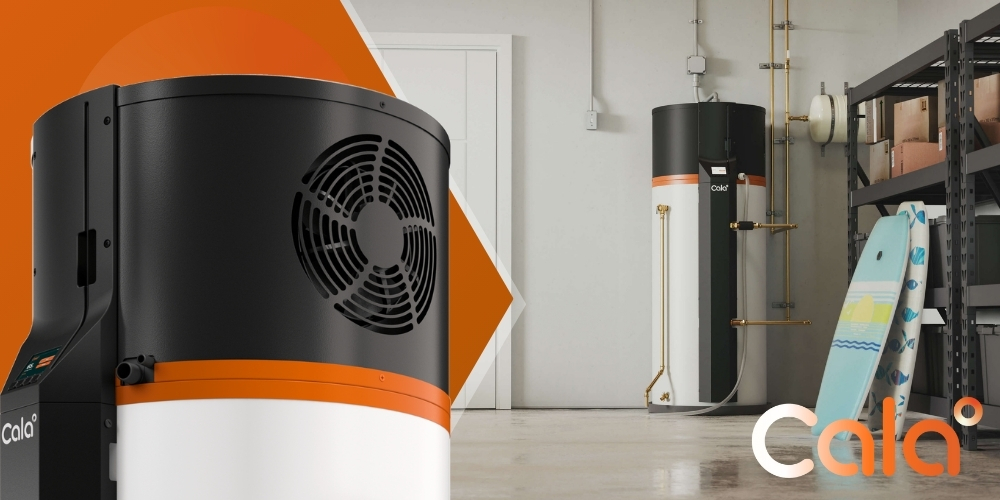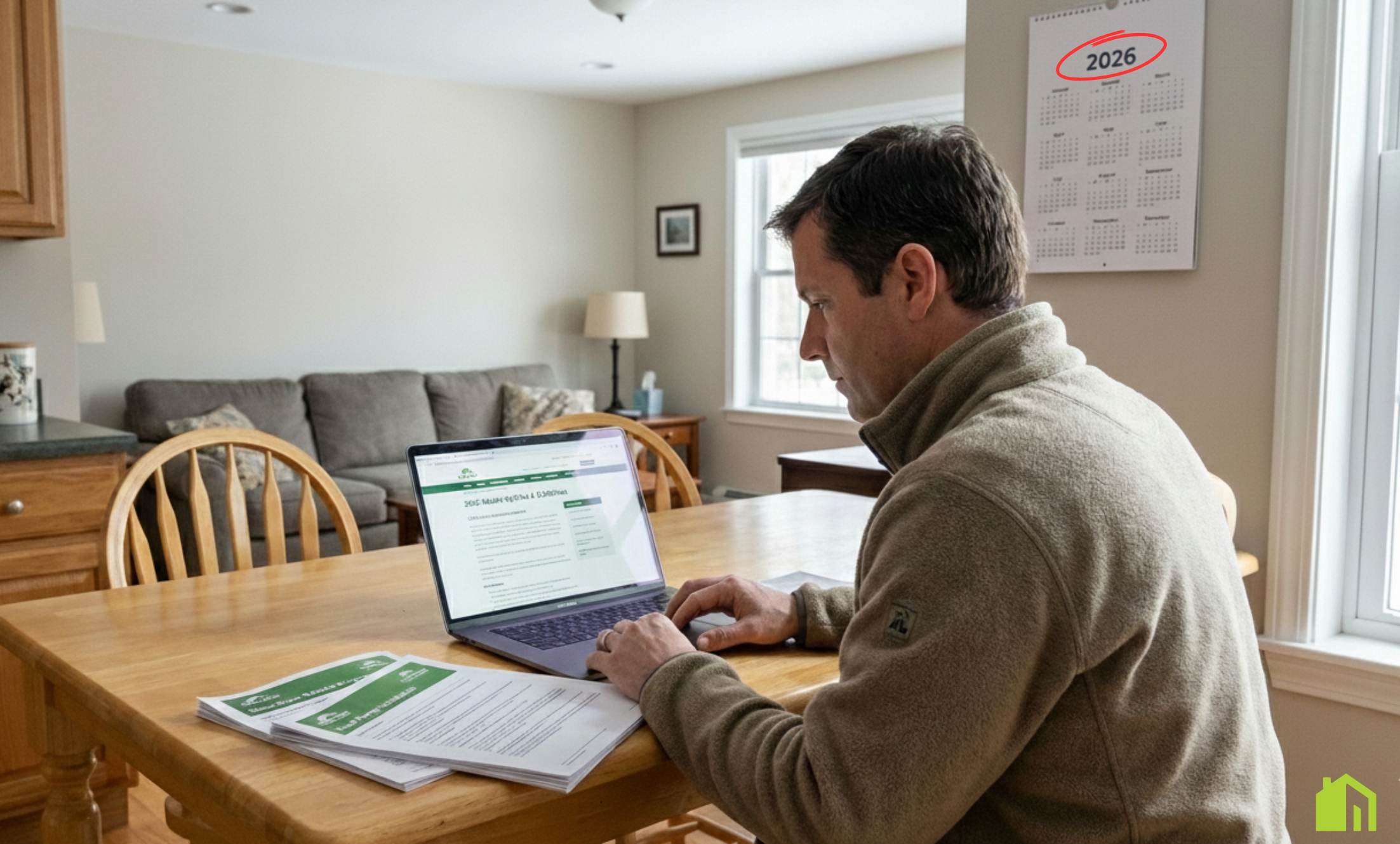Do You Need a Sub Panel for Your Garage, EV, or Home Addition?

Intelligent Heat Pump Water Heaters for Massachusetts Residential Homes — Why SumZero Selects Cala
By SumZero Energy Systems — Massachusetts’ #1 Heat Pump Installation Team
Picking a new water heater once involved a simple decision between gas and standard old electric, praying the hot water wouldn't be gone when there were two showers in a row. That's no longer the case. Now, the ideal solution for the majority of Massachusetts homes is a smart heat pump water heater (HPWH). This isn't the typical hybrid of which you might have heard, but a rather new breed of unit that adapts to your home's schedule, accommodates your energy usage, and maintains comfort consistently while consuming a lot less energy.
When homeowners want to have it exactly right the first time, our team is discerning about what products we choose. We consider the landscape and inspect the details before determining that they might work with Cala, a company that produces a high-technology hot water heater that modern homes need: intelligent, consistent, and efficient hot water — installed properly. This article describes why this alliance matters, how the tech benefits your home, what you should expect from our installation, and the handy information (rebates, credits, fit questions) homeowners inquire about daily.
Why This Alliance Is Important
(and What It Does for You)
There are two parts to a successful hot water solution:
Great technology
A system that makes you comfortable and uses less energy.
Great installation
Design, placement, airflow, electrical, condensate handling, commissioning, and long-term support.
Cala provides a tailor-built, smart HPWH platform. SumZero provides actual-world experience so that it works perfectly in real Massachusetts homes.
Together, we provide three things homeowners report wanting:
Accurate hot water at peak periods without guessing.
Cheaper monthly energy bills without compromise on comfort.
It is a future-proof solution that addresses the trend towards greener, all-electric homes.
Simply put: We get hot water. We know how to properly install heat pump technology. This combination makes a water heater upgrade a smart, long-term decision.
The Homeowner's Dilemma That We Are
If you have had a gas or a typical electric water heater, then you know the problems:
Hot-cold swings on hectic morning routines.
Higher electricity bills than hoped for.
No real insight, no real control.
A replace cycle that is experienced as "buying the same thing again."
Typical hybrid: Heat pump water heaters perform better, yet they still react: They delay until the tank cools off, then warm it up again. Homeowners averred they desire a system which thinks ahead—a unit which is a breeze to operate, handles peak load graciously, and does not make them compromise.
They fill that gap, which is why we work with them.

Why a Smart HPWH is Different
A standard electric water heater makes heat by passing an electric element, a giant toaster coil, through the tank. A heat pump water heater does it another way: it takes heat from the air it lives in and puts it into the water. Because it costs less energy to move heat than create it, heat pump water heaters run on much less power than typical electric ones. And they avoid burning gas, venting, and pollution.
A smart HPWH goes one step further:
It adapts to your home's schedule (morning showers, nighttime laundry) and preheats when demand isn't yet high.
You can use the app to check, plan, or increase hot water whenever you want.
It has a compressor that can change speed to fit what you need (not just "on/off").
It is achievable with a mixing valve holding water at the proper warmth for improved efficiency and then providing a sustained, safe warmth for usage. This is also possible with the availability of additional warm water at peak usage times.
It goes nicely with a contemporary home — primed for solar, time-of-use, and information you can view at a glance.
Result: more stable comfort, less energy use, improved control.
Why a Smart HPWH is Different
From what is visible on-site, there are three things certain for homeowners regarding the points of Cala:
1) Ease That Is Effortless
Consistent hot water at peak use is the ultimate test. Through forecasting demand and using a mixing valve, Cala maintains a steady supply. That results in less "uh oh" when two showers coincidentally happen at once or someone turns on the dishwasher.
2) Controls That You'll Ever Use
App functionality is key when done properly. You can check if there's hot water, turn up the heat for guests, view energy usage history, or simply set it and leave. As installers, we appreciate performance data — it allows us to address little issues before large ones form.
3) Future-Ready from Day One
Massachusetts is going towards clean, electricity-based homes. Cala's strategy combines well: it is scalable for solar power and accounts for time-of-use rates when needed. If you foresee solar energy at some time, or already have it, this water heater won't stop your home from being efficient.
4) A Company That Stands Behind Its Product
Cala backs every unit with a 10-year parts warranty and 3-year labor warranty — a strong sign they stand behind both the technology and the people who install it. At SumZero, we respect that kind of commitment because it mirrors our own approach: taking care of homeowners and supporting our partners with the same level of trust and accountability.
What SumZero Offers As Your Installer
(Why It Matters)
Even the best system won't work so great if installed wrong. Our task is getting your new HPWH working perfectly inside your home, not on a drawing board. This is what our approach is:
Right-size design.
We measure how much water your home needs and discuss the high-flow fixtures, filling bathtubs, and washer usage.
Best installation and ventilation.
HPWHs require air to make the heat move. We consider the room size, doors, vents, and — when necessary — ducting solutions for high performance and low noise.
Clean handling of electricity and condensate.
Safe power, tidy routing, and a trustworthy drainage plan are essential.
Commissioning correctly.
We don't just "turn it on." We verify performance, position the mixing valve, help you with the app, and verify your comfort objectives.
Rebates, credits, and financial assistance.
Mass Save, federal 25C, and the 0% HEAT Loan (if applicable) — we'll help you with that.
We take special care.
Our teams respect your home, protect your floors, and leave the place nicer than they found it.
Aftercare you can count on. Questions years down the road? We're here. The whole concept of a smart system is long-term confidence, not a one-day installation.
Costs, Incentives, and Lifetime Value
Two parts matter here: upfront cost and operating cost.
→ It is a better unit than a standard electric or simple hybrid. Tax credits and rebates make a big difference. A lot of Massachusetts homeowners rely on the 0% HEAT Loan for easier payments.
→ Month after month, the intelligent HPWH's effectiveness is where the value lies. By transferring (not creating) heat and by scheduling heating intelligently, homeowners consistently experience significant decreases in water-heating energy consumption — particularly relative to resistance electric, and many times relative to gas or delivered fuels when full costs are factors.
If you'd like figures specific to your home (household number, showering usage, energy costs), we'll do the math at your consult and provide you with a clear estimate of payback, lifetime cost saving, and the rebates for which you qualify.
Are Smarter Heat Pump Water Heaters Good for Your Home?
It is feasible for many Massachusetts homes. We will cover:
→ Household size and routines. Families with up to about 5 people usually do well with the standard setup; we will give advice for larger families or special situations.
→ Space and ventilation. We check the space, door vents, or ducts if necessary, and ventilation so the system operates properly.
→ Location. Basements are typical, as are utility rooms. As the unit functions, it removes air that feels like a dehumidifier — a typical plus for basements.
→ Electrical. We check panel capacity and proper wiring; no installation day surprises.
→ Future plans. Now or in the future for solar? Time-of-use rates? We'll put the system on so it grows with your home.
[[cta-heatpump]]
Why Is Cala Different from "Traditional Hybrids"?
✪ Control and Convenience:
Cala integrates intelligent tech with a mixing valve to remain comfortable, even when it is busy. Most standard hybrid units have simple modes and react only when the tank becomes chilled.
✪ Care and Trust:
Performance insights help you recognize problems early on and keep you on your feet for surprises. Traditional deployments are mostly "wait and see."
✪ Timing and Efficiency:
Variable driving and improved scheduling assist in energy saving with the maintenance of comfort. Ordinary hybrids operate more often and at undesirable times.
✪ Future-Ready
The design of the Cala accommodates with solar power, intelligent homes, and plans for utilizing electricity. Most older hybrids were not built for that usage.

What to Expect with SumZero
(From the First Call Through the First Shower)
✪ Talk & Pictures
We'll first glance at your objectives and take some fast photos of the current installation: the water heating unit, panel, and surrounding room.
✪ Right-Fit Design
We fit your hot water consumption and available spaces to a design which we endorse.
✪ Chaplain: A Comprehensive
Your quote is going to be transparent, includes information for installation, accessories, and a checklist for incentives. The paperwork assistance takes care of our end.
✪ Professional Installation
Licensed, insured, and detail-orientated. We dispose of the old unit, prepare the site, install and commission a new system, and leave the site tidy.
✪ App Introduction and Instructions
You'll discover how to see hot water supply, schedule increases, and view consumption — without being "technical."
✪ Support and Help
We're your long-term partner. Got a question? You call us — that's what homeowners deserve from the #1 heat pump installation company.
Common Questions We Get
(And Easy Answers)
Smart heat pump water heaters move heat from the surrounding air into the water instead of generating heat directly. This makes them up to three to four times more efficient than standard electric models. Cala’s intelligent system takes it further — it learns your household’s patterns, preheats before busy periods, and gives you app-based control to monitor or boost hot water anytime.
Most hybrid water heaters react when the tank cools. Cala predicts when your home will need hot water and heats proactively, saving more energy while maintaining comfort. It also features a variable-speed compressor, integrated mixing valve, and performance monitoring portal, giving both homeowners and installers a smarter, more reliable experience.
Savings depend on your energy source and usage, but many Massachusetts homeowners cut their water-heating costs by 50–70% when switching to a heat pump system. Cala’s intelligent controls add even greater efficiency. Add Mass Save® rebates, federal 25C tax credits, and potential 0% HEAT Loan financing, and most families see real payback within just a few years.
Yes — most Massachusetts homes are a great fit. Cala’s 65-gallon design comfortably serves households up to five people and can prepare up to 90 gallons ahead of peak use. The system needs adequate space and airflow, similar to a dehumidifier, and our team at SumZero handles every detail — from placement and ducting to electrical and performance checks.
SumZero Energy Systems is Massachusetts’ #1 heat pump installation team, trusted for precision, transparency, and high-quality service. We manage every step — design, installation, rebate paperwork, app setup, and long-term maintenance — so homeowners enjoy smarter comfort and lasting confidence. With SumZero, you’re not just buying equipment; you’re gaining a partner who stands behind it.
Why We Feel Secure Recommending This to Massachusetts Homeowners
We have a simple promise: we only install solutions that we would use in our own homes. Cala’s approach — being smart, having control, and being ready for the future — matches what we have learned from many talks with homeowners in the state. Together with SumZero’s careful installation standards and ongoing support, this water-heating upgrade makes sense right away and will last well with your home. Cleaner heat. Smarter comfort. Fewer bills.
Ready to Take the Next Step?

To learn more about Cala’s technology and vision, visit Cala Systems.
Understanding Sub Panel Installation for Massachusetts Homes
As more homeowners in Massachusetts add electric vehicles, expand their garages, or take on home additions, the need for additional electrical capacity becomes unavoidable. One common and practical solution is installing a sub panel. But what exactly is a sub panel, and how do you know if you need one?
Whether you're planning a garage workshop, installing a Level 2 EV charger, or adding a new bedroom, gaining a better understanding of electrical sub panel installation can save you time, money, and safety worries.
Many older Massachusetts homes still rely on outdated 100-amp service, which often isn't enough for modern electrical demands like EV chargers and heat pump systems.
Let’s dive into the key reasons you might need to install a sub panel—and what it can do for your home.
Why You Might Need a Sub Panel for Your Garage
Garages are becoming more than storage spaces. Today, they serve as EV charging stations, workshops, and expanded living areas. But all these require more power than your main electrical panel may offer.
When Garage Projects Outgrow Your Main Panel
Most standard panels in older homes weren’t built to handle the energy load of today’s amenities. Here are common scenarios where sub panel installation in your garage makes sense:
- Installing an EV charging station (especially Level 2 chargers)
- Adding workbenches with multiple power tools or compressors
- Converting your garage into an office or studio space
- Installing lighting, heating systems, or smart home automation
Even a new garage door motor and LED lighting system can require more amps than expected, pushing your main panel past a safe capacity.
Benefits of a Garage Sub Panel
Adding a sub panel in your garage can:
- Improve safety by spreading out power load
- Make it more convenient to shut off power for garage-specific circuits
- Allow future upgrades without touching the main panel again
- Prevent frequent breaker trips due to overloads
If you plan to use your garage for more than storing your car, a sub panel makes layout and design much easier. It also brings code compliance into the picture—especially critical during home resale or inspections.
Do You Need a Sub Panel for an EV Charger?
Massachusetts is rapidly adopting electric vehicles, and with that comes growing infrastructure needs at home. One of the most overlooked elements is whether your main panel can handle the new power demand.
Understanding Power Needs of EV Chargers
Most electric vehicles, especially when using a Level 2 home charger, require a 240-volt outlet and dedicated circuit. This can add up to 50 amps of demand to your home’s system. If your current panel is already fully loaded, you’ll run into safety risks by forcing new circuits into a crowded box.
Important factors to consider:
- Your panel's current amperage rating and capacity
- Number of open breaker slots
- Existing appliances and their electricity use
- Total home power consumption during peak times
Why Sub Panels Make EV Charging Easier
Installing a sub panel gives your EV charger a dedicated and properly sized power source. Alongside that, it enhances your home’s electrical stability and allows for smoother future upgrades—such as a second vehicle charger or battery storage.
Here’s where a sub panel benefits Massachusetts EV owners:
- Avoids costly full-panel rewiring
- Keeps EV-specific circuits separate and easier to maintain
- Adds flexibility for solar or battery integration in the future
According to Mass Save®, EV home charger installations are one of the top incentives Massachusetts residents are taking advantage of—all requiring sound electrical planning.
[[cta-heatpump]]
Are Sub Panels Necessary for Home Additions?
Whether it’s a new sunroom, finished basement, or expanded kitchen, any home addition usually comes with extra plugs, lighting, electric radiators, and more. Adding all these connections to your existing panel can seriously strain its capacity.
Evaluating If You Need One
Before beginning a home addition, determine if your current electrical system can handle the new load safely and efficiently. Key indicators for needing a sub panel include:
- No extra breaker slots available in main panel
- Frequent breaker trips during daily use
- Multiple high-energy appliances planned in the addition
- Distance between the main panel and the addition area
If your addition is physically far from your main panel, a sub panel also helps limit the amount of wiring needed and improves system efficiency.
Benefits of Sub Panel Upgrades During a Renovation
Installing a sub panel during any major project future-proofs your home layout and simplifies inspections. It also:
- Localizes power control for the new space
- Reduces breaker confusion
- Keeps your main panel clean and organized
- Simplifies future maintenance and circuit labeling
Think of the sub panel as your 'electric command center' for the new space—especially useful when planning light control zones, installing a mini-split system, or preparing for smart-home integration.
How Much Does It Cost to Install a Sub Panel in Massachusetts?
Costs can vary based on location, the size of the sub panel, and labor requirements. However, Massachusetts homeowners typically pay between $500 and $1,800 for sub panel installation, including permits and materials.
Key cost factors:
- Amperage of the sub panel (e.g., 60A, 100A)
- Number of circuits needed
- Distance from the main panel
- Panel brand and outdoor vs indoor rating
- Modification needs on your existing electrical setup
The cost to install a sub panel is often far less than upgrading your entire main panel, making it a budget-friendly way to meet growing energy demands.
To ensure code compliance, it's also critical to follow Massachusetts building and energy codes, which may require additional inspections or documentation. Always check Massachusetts electrical regulations before starting your project.
Final Thoughts for Massachusetts Homeowners
Installing a sub panel is about more than just adding circuits—it’s about building a safer, more flexible electrical system that grows with your needs. With electric vehicle adoption rising, workshops blooming in converted garages, and home additions transforming living spaces, staying ahead of your power demands is key.
If you’re unsure whether you need a sub panel, a detailed load calculation and a review of your panel’s available breaker space is a good place to start. It’s also an excellent opportunity to align with energy efficiency goals, such as heat pump integration or smart system upgrades in the near future.
Well-planned electrical sub panel upgrades can make your home safer and more valuable, while laying the groundwork for future home innovations—right here in Massachusetts.
Ensure your home is ready for EV charging, garage upgrades, or additions with expert sub panel installation in Massachusetts—safe, efficient, and built for your future electrical needs.
Upgrade Your Sub PanelYou Might Also Like…
Continue learning with handpicked articles that inform and inspire.
Not Sure Where to Start? We’ll Guide You
Let our experts design the right heating and cooling solution—customized for your comfort, your layout, and your energy goals. No pressure. Just clarity.
Request FREE ESTIMATE









